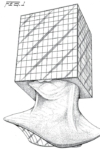by Max Rivlin-Nadler
When the subject is the emotional overload of adolescence, the age of the author matters — as one hurtles into adulthood, that illusory time becomes diminished. Childhood becomes a projection of our adult selves, a reduction of memories to either seminal or secondary status. A writer, a young writer, which is actually the age of an old ball-player, has almost an obligation to mine the inexplicable feelings of adolescence. In doing so, Karen Russell turns the stinky grit of the teenagers in Swamplandia!‘s Bigtree clan into a rhapsody of loss, propelled by the meter of the The Inferno and phrasing strains from Housekeeping.
The Bigtree family, first seen in Russell’s short story “Ava Wrestles the Alligator,” runs a tourist trap off the swampy coast of Florida. There they wrestle alligators for ferry-loads of mainlanders and merchandise their “tribe,” which is pitch-perfectly rooted in the worst of Americana. The family, descendants of Ohio coal miners, applies bronzer for family portraits and wears headdresses- their patriarch is known as “Chief”. The three Bigtree children are home-schooled and run the attraction, while their mother, Hilola Bigtree, is the star of the show. Hillola’s sudden death, at the hands of no more beastly a fate than cancer, throws the attraction into turmoil. The crowds disappear and the Chief returns to the Mainland, in search of funding for Swamplandia!’s next incarnation, something he refers to as “Carnival Darwinism”. Assuredly, its even more ludicrous than their original production. Even more threatening than the figurative darkness that has engulfed the family, is the literal “World of Darkness,” a new attraction that is squarely aimed at the same rabble that used to patronize the Bigtree’s. Each child, in turn, leaves their home. Kiwi, the eldest, tries to raise money for the families’ debilitating debt; Ossie, the middle child, runs off to marry a ghost; Eva, the youngest and our protagonist, goes looking for her sister in what might be the underworld. And if the underworld exists anywhere, it’s probably in the Everglades.
Embedded in this incredible, water-logged, mosquito-ridden trip through the sensual and angry world is an even greater feat: Swamplandia! is wonderfully absurd and genuinely hilarious. The sheltered life led by the Bigtree children is a naive vantage from which to view the consumer culture. Ossie likes a song because “they sang about things that were exotic to us, like corn and car accidents.” The novel’s reality is exaggerated, but its fantastic elements are hardly called to attention. Like Russell’s earlier stories, once the conceit is revealed (these girls act like wolves), the focus becomes less grotesque and more emotional. In an interview with Tin House, Russell explained, “the stories I like best are funny, absurd, surreal and deeply serious, if by ‘serious’ we mean deeply engaged with the root mysteries of our existence…humor surges up from the void, from the absurdity of being alive”. The humor and generosity of the book are its strength, if only because at its core is a sense of great loss.
Ava summarizes the Bigtree narrative for us early in the novel, “we fell.” The family never recovers their business, and just barely survives their separate ordeals intact (only Kiwi truly soars). Swamplandia! describes a point of maturation where the distinction between that which we want to be true is dismissed and we’re left to take stock of what we have. How badly can we wish for the supernatural to be true? Quite badly. And if the revelation received on our quests are only internal and without analogues in the physical world, is that enough? Probably not. But fiction succeeds because our imagination refuses to accept the end of any experience. Swamplandia! is then a work of great imagination- the Bigtrees are always going to be wrestling with their alligators. Ava concludes her story in a vague, hopeful way, “I like to think our family is winning”.
This post may contain affiliate links.








